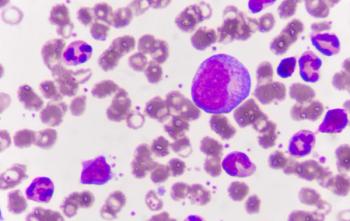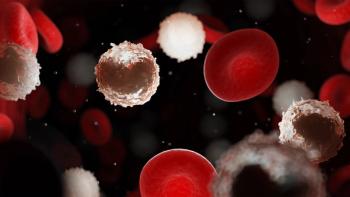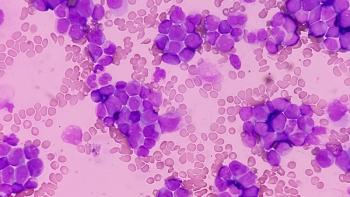
First-Line Tremelimumab/Durvalumab/Chemotherapy May Become New Standard of Care in EGFR/ALK Wild-Type NSCLC

The combination of tremelimumab plus durvalumab plus chemotherapy, which was recently approved for patients with non–small cell lung cancer, could represent a new standard of care.
Durvalumab (Imfinzi), with or without tremelimumab-actl (Imjudo), combined with chemotherapy, improved progression-free survival (PFS) among patients with EGFR/ALK wild-type non–small cell lung cancer (NSCLC), according to findings from the phase 3 POSEIDON trial (NCT03164616), published in the Journal of Clinical Oncology.1
The primary end point of the study was to assess benefit of durvalumab plus chemotherapy vs chemotherapy alone. Upon meeting the primary PFS outcome and secondary overall survival (OS) outcome, an analysis of the triplet regimen vs chemotherapy alone was also conducted.
Compared with chemotherapy alone (n = 337), which was associated with a median PFS of 4.8 months, durvalumab plus chemotherapy (n = 338) resulted in a median PFS of 5.5 months (HR, 0.74; 95% CI, 0.62-0.89; P = .0009). The 12-month PFS rates were 13.1% and 24.4%, respectively.
Although the immunotherapy did show a trend towards improving overall survival (OS) over chemotherapy alone, the improvement did not achieve statistical significance (HR, 0.86; 95% CI, 0.72-1.02; P = .0758). The median OS between the 2 groups was 13.3 vs 11.7 months, and the 24-month OS rates were 29.6% vs 22.1% with the combination and chemotherapy alone, respectively. Both PFS and OS benefit were reported to be consistent across patient subgroups.
In the analysis of the of tremelimumab/durvalumab/chemotherapy vs chemotherapy alone, there was a statistically significant improvement in PFS (6.2 months vs 4.8 months; HR, 0.72; 95% CI, 0.60-0.86; P = .0003), with 12-month PFS rates of 26.6% and 13.1%, respectively. The median OS was 14.0 months vs 11.7 months (HR, 0.77; 95% CI, 0.65-0.92; P = .0030). The 24-month OS rates were 32.9% vs 22.1%.
Moreover, the regimens were observed to be tolerable. Across all arms, the most common adverse effects (AEs) were those typically observed with chemotherapy, and treatment discontinuation rates were similar between the different cohorts.
The rates of treatment-related AEs (TRAEs) with the triplet regimen of durvalumab/tremelimumab/chemotherapy, durvalumab plus chemotherapy, or chemotherapy alone, were 51.8%, 44.6%, and 44.4%, respectively. The most common TRAEs of maximum grades 3 or 4 were anemia and neutropenia. Ultimately, 15.5%, 14.1%, and 9.9% of patients required treatment discontinuation because of AEs.
“Durvalumab plus chemotherapy significantly improved PFS and tremelimumab plus durvalumab plus chemotherapy significantly improved OS and PFS vs [chemotherapy],” Melissa L. Johnson, MD, of the Sarah Cannon Research Institute, and coinvestigators, wrote in the study. “Adding a limited course of tremelimumab to durvalumab and 4 cycles of chemotherapy provided long-term survival benefit for patients with metastatic NSCLC, alongside early disease control and a manageable tolerability profile, without compromising treatment exposure.”
The 3-arm trial evaluated patients with metastatic NSCLC who received tremelimumab/durvalumab/chemotherapy, durvalumab plus chemotherapy, or chemotherapy alone, as frontline treatment.
The trial enrolled and randomly assigned 1013 patients 1:1:1 across 142 sites in 18 countries between June 2017, and September 2018. Patients assigned to the tremelimumab at 75-mg plus 1500 mg durvalumab and platinum-based chemotherapy for up to four 21-day cycles, followed by 1 dose of durvalumab every 4 weeks. Patients in the doublet arm received durvalumab plus chemotherapy for up to four 21-day cycles, followed by durvalumab once very 4 weeks until progression. Patients receiving chemotherapy alone received up to six 21-day cycles (with or without maintenance pemetrexed).
As of March 12, 2021, patients receiving the triplet combination (n = 338), and the chemoimmunotherapy combination (n = 338), had received a median of 8 durvalumab doses. In the triplet combination arm, 218 (66.1%) of patients had received the 5 planned doses of tremelimumab. Progressive disease represented the main reason patients discontinued tremelimumab.
Unconfirmed objective response rates (ORR) showed that the triplet combination elicited an ORR of 46.3% vs 33.4% with chemotherapy alone (OR, 1.72; 95% CI, 1.26-2.37) The ORR with durvalumab/chemotherapy was 48.5% (OR, 1.90; 95% CI, 1.38-2.62). In a post hoc analysis, the confirmed ORR for the triplet, durvalumab/chemotherapy, and chemotherapy alone, was 38.8%, 41.5%, and 24.4%.
For patients who achieved a confirmed response, the median duration of response was 9.5 months in the triplet regimen arm (95% CI, 7.2-not estimable), 7.0 months with the chemoimmunotherapy (95% CI, 5.7-9.9), and 5.1 months with chemotherapy alone (95% CI, 4.4-6.0).
Between the 3 arms, the rate of any-grade AEs was 92.7% (n = 306), 88.6% (n = 294), and 89.5% (n = 298). Treatment-related deaths occurred in 3.3% (n = 11), 2.1% (n =7), and 2.4% (n = 8).
Immune-mediated AEs occurred in 33.6%, 19.2%, and 5.1% of patients in the tremelimumab/durvalumab/chemotherapy, durvalumab/chemotherapy, and chemotherapy alone arms. For maximum grade 3 or 4 AEs, the rates were 10.0%, 6.9%, and 1.5%, respectively. Serous irAEs occurred in 5.8%, 4.2%, and 0.6% of patients, of which 0.6%, 0.3%, and 0%, respectively, were fatal.
Study authors noted that the trial’s global design represents both a strength and a limitation; as the results are both applicable to a real-world setting, but also represent a heterogeneous patient population, complicating interpretation. Moreover, at the time of trial design, chemotherapy represented the standard of care in this setting, however advances in NSCLC treatment have meant that in many regions, chemotherapy is no longer the standard.
Based on findings from POSEIDON,
Study authors concluded by noting that the addition of anti–CTLA-4 delivered an extended clinical benefit to patients with PD-L1 staining on tumor cell less than 1%, a subgroup with hard-to-treat disease and limited treatment options. Additional analysis of efficacy by PD-L1 expression level and blood tumor mutational burden, will be reported separately.
“Tremelimumab plus durvalumab plus chemotherapy may represent a new first-line treatment option in metastatic NSCLC,” authors concluded.
Reference
Johnson ML, Cho BC, Luft A, et al; POSEIDON investigators. Durvalumab with or without tremelimumab in combination with chemotherapy as first-line therapy for metastatic non-small-cell lung cancer: the phase III POSEIDON study. Published online November 3, 2022. J Clin Oncol. doi:10.1200/JCO.22.00975
Newsletter
Knowledge is power. Don’t miss the most recent breakthroughs in cancer care.
















































































